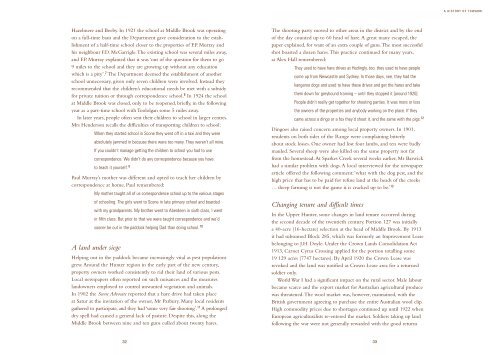Remembering Country: History & Memories of Towarri National Park ...
Remembering Country: History & Memories of Towarri National Park ...
Remembering Country: History & Memories of Towarri National Park ...
Create successful ePaper yourself
Turn your PDF publications into a flip-book with our unique Google optimized e-Paper software.
Hazelmere and Beeby. In 1921 the school at Middle Brook was operating<br />
on a full-time basis and the Department gave consideration to the establishment<br />
<strong>of</strong> a half-time school closer to the properties <strong>of</strong> F.P. Murray and<br />
his neighbour F.D. McGarrigle.The existing school was several miles away,<br />
and F.P. Murray explained that it was ‘out <strong>of</strong> the question for them to go<br />
9 miles to the school and they are growing up without any education<br />
which is a pity’. 7 The Department deemed the establishment <strong>of</strong> another<br />
school unnecessary, given only seven children were involved. Instead they<br />
recommended that the children’s educational needs be met with a subsidy<br />
for private tuition or through correspondence school. 8 In 1924 the school<br />
at Middle Brook was closed, only to be reopened, briefly, in the following<br />
year as a part-time school with Toololgan some 5 miles away.<br />
In later years, people <strong>of</strong>ten sent their children to school in larger centres.<br />
Mrs Henderson recalls the difficulties <strong>of</strong> transporting children to school:<br />
When they started school in Scone they went <strong>of</strong>f in a taxi and they were<br />
absolutely jammed in because there were too many. They weren’t all mine.<br />
If you couldn’t manage getting the children to school you had to use<br />
correspondence. We didn’t do any correspondence because you have<br />
to teach it yourself. 9<br />
Paul Murray’s mother was different and opted to teach her children by<br />
correspondence at home. Paul remembered:<br />
My mother taught all <strong>of</strong> us correspondence school up to the various stages<br />
<strong>of</strong> schooling. The girls went to Scone in late primary school and boarded<br />
with my grandparents. My brother went to Aberdeen in sixth class, I went<br />
in fifth class. But prior to that we were taught correspondence and we’d<br />
sooner be out in the paddock helping Dad than doing school. 10<br />
A land under siege<br />
Helping out in the paddock became increasingly vital as pest populations<br />
grew.Around the Hunter region in the early part <strong>of</strong> the new century,<br />
property owners worked consistently to rid their land <strong>of</strong> various pests.<br />
Local newspapers <strong>of</strong>ten reported on such nuisances and the measures<br />
landowners employed to control unwanted vegetation and animals.<br />
In 1902 the Scone Advocate reported that a hare drive had taken place<br />
at Satur at the invitation <strong>of</strong> the owner, Mr Parbury. Many local residents<br />
gathered to participate, and they had ‘some very fair shooting’. 11 A prolonged<br />
dry spell had caused a general lack <strong>of</strong> pasture. Despite this, along the<br />
Middle Brook between nine and ten guns culled about twenty hares.<br />
32<br />
The shooting party moved to other areas in the district and by the end<br />
<strong>of</strong> the day counted up to 60 head <strong>of</strong> hare. A great many escaped, the<br />
paper explained, for want <strong>of</strong> an extra couple <strong>of</strong> guns.The most successful<br />
shot boasted a dozen hares.This practice continued for many years,<br />
as Alex Hall remembered:<br />
They used to have hare drives at Hedingly, too; they used to have people<br />
come up from Newcastle and Sydney. In those days, see, they had the<br />
kangaroo dogs and used to have these drives and get the hares and take<br />
them down for greyhound training – until they stopped it [around 1920].<br />
People didn’t really get together for shooting parties. It was more or less<br />
the owners <strong>of</strong> the properties and anybody working on the place. If they<br />
came across a dingo or a fox they’d shoot it, and the same with the pigs. 12<br />
Dingoes also raised concern among local property owners. In 1901,<br />
residents on both sides <strong>of</strong> the Range were complaining bitterly<br />
about stock losses. One owner had lost four lambs, and ten were badly<br />
mauled. Several sheep were also killed on the same property not far<br />
from the homestead. At Sparkes Creek several weeks earlier, Mr Barwick<br />
had a similar problem with dogs. A local interviewed for the newspaper<br />
article <strong>of</strong>fered the following comment:‘what with the dog pest, and the<br />
high price that has to be paid for refuse land at the heads <strong>of</strong> the creeks<br />
… sheep farming is not the game it is cracked up to be.’ 13<br />
Changing tenure and difficult times<br />
In the Upper Hunter, some changes in land tenure occurred during<br />
the second decade <strong>of</strong> the twentieth century. Portion 127 was initially<br />
a 40-acre (16-hectare) selection at the head <strong>of</strong> Middle Brook. By 1913<br />
it had subsumed Block 285, which was formerly an Improvement Lease<br />
belonging to J.H. Doyle. Under the Crown Lands Consolidation Act<br />
1913, Carnet Cyrus Crossing applied for the portion totalling some<br />
19 129 acres (7747 hectares). By April 1920 the Crown Lease was<br />
revoked and the land was notified as Crown Lease area for a returned<br />
soldier only.<br />
World War I had a significant impact on the rural sector. Male labour<br />
became scarce and the export market for Australian agricultural produce<br />
was threatened.The wool market was, however, maintained, with the<br />
British government agreeing to purchase the entire Australian wool clip.<br />
High commodity prices due to shortages continued up until 1922 when<br />
European agriculturalists re-entered the market. Soldiers taking up land<br />
following the war were not generally rewarded with the good returns<br />
33<br />
A HISTORY OF TOWARRI

















